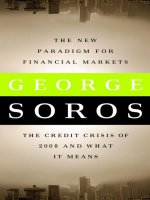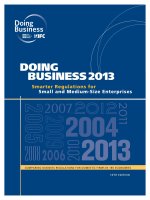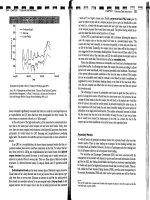Emerging Needs and Tailored Products for Untapped Markets by Luisa Anderloni, Maria Debora Braga and Emanuele Maria Carluccio_5 pdf
Bạn đang xem bản rút gọn của tài liệu. Xem và tải ngay bản đầy đủ của tài liệu tại đây (598.44 KB, 27 trang )
5.2 Stochastic Chaos Model 119
0 5 10 15 20 25 30
0
0.1
0.2
0.3
0.4
0.5
0.6
0.7
0.8
0.9
1
y
0
= .001
y
0
= .5
y
0
= .99
FIGURE 5.2. Stochastic chaos process for different initial conditions
TABLE 5.1. In-Sample Diagnostics: Stochastic
Chaos Model (Structure: 4 Lags, 3 Neurons)
Diagnostic Linear Model (Network Model)
Estimate
R
2
.29 (.53)
HQIF 1534 (1349)
L-B
∗
.251
M-L
∗
.0001
E-N
∗
.0000
J-B
∗
.55
L-W-G 1000
B-D-S∗ .0000
∗
marginal significance levels
network model, appearing in parentheses, explains 53%. The Hannan-
Quinn information criterion favors, not surprisingly, the network model.
The significance test of the Q statistic shows that we cannot reject serial
independence of the regression residuals. By all other criteria, the linear
120 5. Estimating and Forecasting with Artificial Data
0 50 100 150 200 250 300 350 400
−0.6
−0.4
−0.2
0
0.2
0.4
0.6
0.8
Linear Model
Network Model
FIGURE 5.3. In-sample errors: stochastic chaos model
specification suffers from serious specification error. There is evidence of
serial correlation in squared errors, as well as non-normality, asymmetry,
and neglected nonlinearity in the residuals. Such indicators would suggest
the use of nonlinear models as alternatives to the linear autoregressive
structure.
Figure 5.3 pictures the error paths predicted by the linear and network
models. The linear model errors are given by the solid curve and the net-
work errors by dotted paths. As expected, we see that the dotted curves
generally are closer to zero.
5.2.2 Out-of-Sample Performance
The path of the out-of-sample prediction errors appears in Figure 5.4. The
solid path represents the forecast error of the linear model while the dotted
curves are for the network forecast errors. This shows the improved per-
formance of the network relative to the linear model, in the sense that its
errors are usually closer to zero.
Table 5.2 summarizes the out-of-sample statistics. These are the root
mean squared error statistics (RMSQ), the Diebold-Mariano statistics for
lags zero through four (DM-0 to DM-4), the success ratio for percentage
5.2 Stochastic Chaos Model 121
0 10 20 30 40 50 60 70 80 90 100
−0.6
−0.4
−0.2
0
0.2
0.4
0.6
0.8
Linear Model
Network Model
FIGURE 5.4. Out-of-sample prediction errors: stochastic chaos model
TABLE 5.2. Forecast Tests: Stochastic Chaos Model
(Structure: 5 Lags, 4 Neurons)
Diagnostic Linear Neural Net
RMSQ .147 .117
DM-0
∗
— .000
DM-1
∗
— .004e-5
DM-2
∗
— .032e-5
DM-3
∗
— .115e-5
DM-4
∗
— .209e-5
SR 1 1
B-Ratio — .872
∗
marginal significance levels
of correct sign predictions (SR), and the bootstrap ratio (B-Ratio), which
is the ratio of the network bootstrap error statistic to the linear boot-
strap error measure. A value less than one, of course, represents a gain for
network estimation.
122 5. Estimating and Forecasting with Artificial Data
The results show that the root mean squared error statistic of the network
model is almost 20% lower than that of the linear model. Not surprisingly,
the Diebold-Mariano tests with lags zero through four are all significant.
The success ratio for both models is perfect, since all of the returns in
the stochastic chaos model are positive. The final statistic is the boot-
strap ratio, the ratio of the network bootstrap error relative to the linear
bootstrap error. We see that the network reduces the bootstrap error by
almost 13%.
Clearly, if underlying data were generated by a stochastic process,
networks are to be preferred over linear models.
5.3 Stochastic Volatility/Jump Diffusion Model
The SVJD model is widely used for representing highly volatile asset
returns in emerging markets such as Russia or Brazil during periods
of extreme macroeconomic instability. The model combines a stochastic
volatility component, which is a time-varying variance of the error term,
as well as a jump diffusion component, which is a Poisson jump process.
Both the stochastic volatility component and the Poisson jump components
directly affect the mean of the asset return process. They are realistic para-
metric representations of the way many asset returns behave, particularly
in volatile emerging-market economies.
Following Bates (1996) and Craine, Lochester, and Syrtveit (1999), we
present this process in continuous time by the following equations:
dS
S
=(µ −λ
k) · dt +
√
V · dZ + k ·dq (5.2)
dV =(α −βV ) · dt + σ
v
√
V · dZ
v
(5.3)
Corr(dZ, dZ
v
)=ρ (5.4)
prob(dq =1)=λ ·dt (5.5)
ln(1 + k) ∼ φ(ln[1 +
k] − .5κ, κ
2
) (5.6)
where dS/S is the rate of return on an asset, µ is the expected rate of
appreciation, λ the annual frequency of jumps, and k is the random per-
centage jump conditional on the jump occurring. The variable ln(1 + k)is
distributed normally with mean ln[1+
k]−.5κ and variance κ
2
. The symbol
φ represents the normal distribution. The advantage of the continuous time
representation is that the time interval can become arbitrarily smaller and
approximate real time changes.
5.3 Stochastic Volatility/Jump Diffusion Model 123
TABLE 5.3. Parameters for SVJD Process
Mean return µ .21
Mean volatility α .0003
Mean reversion of volatility β .7024
Time interval (daily) dt 1/250
Expected jump
k .3
Standard deviation of percentage jump κ .0281
Annual frequency of jumps λ 2
Correlation of Weiner processes ρ .6
The instantaneous conditional variance V follows a mean-reverting
square root process. The parameter α is the mean of the conditional vari-
ance, while β is the mean-reversion coefficient. The coefficient σ
v
is the
variance of the volatility process, while the noise terms dZ and dZ
v
are the
standard continuous-time white noise Weiner processes, with correlation
coefficient ρ.
Bates (1996) points out that this process has two major advantages.
First, it allows systematic volatility risk, and second, it generates an “ana-
lytically tractable method” for pricing options without sacrificing accuracy
or unnecessary restrictions. This model is especially useful for option
pricing in emerging markets.
The parameters used to generate the SVJD process appear in Table 5.3.
In this model, S
t+1
is equal to S
t
+[S
t
·(µ−λk)] ·dt, and for a small value
of dt will be unit-root nonstationary. After first-differencing, the model will
be driven by the components of dV and k·dq, which are random terms. We
should not expect the linear or neural network model to do particularly well.
Put another way, we should be suspicious if the network model significantly
outperforms a rather poor linear model.
One realization of the SVJD process, after first-differencing, appears in
Figure 5.5. As in the case of the stochastic chaos model, there are periods
of high volatility followed by more tranquil periods. Unlike the stochastic
chaos model, however, the periods of tranquility are not perfectly flat.
We also notice that the returns in the SVJD model are both positive and
negative.
5.3.1 In-Sample Performance
Table 5.4 gives the in-sample regression diagnostics of the linear model.
Clearly, the linear approach suffers serious specification error in the error
structure. Although the network multiple correlation coefficient is higher
than that of the linear model, the Hannan-Quinn information criterion
only slightly favors the network model. The slight improvement of the R
2
statistic does not outweigh by too much the increase in complexity due to
124 5. Estimating and Forecasting with Artificial Data
0 50 100 150 200 250 300 350 400 450 500
−1
−0.8
−0.6
−0.4
−0.2
0
0.2
0.4
0.6
0.8
FIGURE 5.5. Stochastic volatility/jump diffusion process
TABLE 5.4. In-Sample Diagnostics: First-Differenced
SVJD Model (Structure: 4 Lags, 3 Neurons)
Diagnostic Linear Model (Network Model)
Estimate
R
2
.42 (.45)
HQIF 935 (920)
L-B
∗
.783
M-L
∗
.025
E-N
∗
.0008
J-B
∗
0
L-W-G 11
B-D-S∗ .0000
∗
marginal significance levels
the larger number of parameters to be estimated. While the Lee-White-
Granger test does not turn up evidence of neglected nonlinearity, the BDS
test does. Figure 5.6 gives in-sample errors for the SVJD realizations. We
do not see much difference.
5.4 The Markov Regime Switching Model 125
0 50 100 150 200 250 300 350 400
−0.8
−0.6
−0.4
−0.2
0
0.2
0.4
0.6
Linear
Network
FIGURE 5.6. In-sample errors: SVJD model
5.3.2 Out-of-Sample Performance
Figure 5.7 pictures the out-of-sample errors of the two models. As expected,
we do not see much difference in the two paths.
The out-of-sample statistics appearing in Table 5.5 indicate that the
network model does slightly worse, but not significantly worse, than the lin-
ear model, based on the Diebold-Mariano statistic. Both models do equally
well in terms of the success ratio for correct sign predictions, with slightly
better performance by the network model. The bootstrap ratio favors the
network model, reducing the error percentage of the linear model by slightly
more than 3%.
5.4 The Markov Regime Switching Model
The Markov regime switching model is widely used in time-series analysis
of aggregate macro data such as GDP growth rates. The basic idea of the
126 5. Estimating and Forecasting with Artificial Data
0 10 20 30 40 50 60 70 80 90 100
−0.6
−0.5
−0.4
−0.3
−0.2
−0.1
0
0.1
0.2
0.3
0.4
Linear Model
Network Model
FIGURE 5.7. Out-of-sample prediction errors: SVJD model
TABLE 5.5. Forecast Tests: SVJD Model (Structure:
4 Lags, 3 Neurons)
Diagnostic Linear Neural Net
RMSQ .157 .167
DM-0
∗
— .81
DM-1
∗
— .74
DM-2
∗
— .73
DM-3
∗
— .71
DM-4
∗
— .71
SR .646 .656
B-Ratio —– .968
∗
marginal significance levels
regime switching model is that the underlying process is linear. However,
the process follows different regimes when the economy is growing and
when the economy is shrinking. Originally due to Hamilton (1990), it was
applied to GDP growth rates in the United States.
5.4 The Markov Regime Switching Model 127
Following Tsay (2002, p. 135–137), we simulate the following model rep-
resenting the rate of growth of GDP for the U.S. economy for two states in
the economy, S
1
and S
2
:
x
t
= c
c
+
p
i−1
φ
1,i
x
t−i
+ ε
1,i
,ε
1
˜φ(0,σ
2
1
), if S = S
1
= c
2
+
p
i−1
φ
2,i
x
t−i
+ ε
2,i
ε
2
˜φ(0,σ
2
2
)ifS = S
2
(5.7)
where φ represents the Gaussian density function. These states have the
following transition matrix, P, describing the probability of moving from
one state to the next, from time (t −1) to time t:
P =
(S
1
t,
|S
1
t−1,
)(S
1
t,
|S
2
t−1,
)
(S
2
t,
|S
1
t−1,
)(S
2
t,
|S
2
t−1,
)
=
(1 −w
2
) w
2
w
1
(1 −w
1
)
(5.8)
The MRS model is essentially a combination of two linear models with
different coefficients, with a jump or switch pushing the data-generating
mechanism from one model to the other. So there is only a small degree
of nonlinearity in this system. The parameters used for generating 500
realizations of the MRS model appear in Table 5.6.
Notice that in the specification of the transition probabilities, as Tsay
(2002) points out, “it is more likely for the U.S. GDP to get out of a
contraction period than to jump into one” [Tsay (2002), p. 137]. In our
simulation of the model, the transition probability matrix is called from
a uniform random number generator. If, for example, in state S = S
1
, a
random value of .1 is drawn, the regime will switch to the second state,
S = S
2
. If a value greater than .118 is drawn, then the regime will remain
in the first state, S = S
1
.
TABLE 5.6. Parameters for MRS Process
Parameter State 1 State 2
c
i
.909 −.420
φ
i,1
.265 .216
φ
i,2
.029 .628
φ
i,3
−.126 −.073
φ
i,4
−.110 −.097
σ
i
.816 1.01
w
i
.118 .286
128 5. Estimating and Forecasting with Artificial Data
0 50 100 150 200 250 300 350 400 450 500
−6
−5
−4
−3
−2
−1
0
1
2
3
4
FIGURE 5.8. Markov switching process
The process {x
t
} exhibits periodic regime changes, with different dynam-
ics in each regime or state. Since the representative forecasting agent does
not know that the true data-generating mechanism for {x
t
} is a Markov
regime switching model, a unit root test for this variable cannot reject an
I(1) or nonstationary process. However, work by Lumsdaine and Papell
(1997) and Cook (2001) has drawn attention to the bias of unit root tests
when structural breaks take place. We thus approximate the process {x
t
}
as a stationary process.
The underlying data-generating mechanism is, of course, near linear,
so we should not expect great improvement from neural network approxi-
mation. One realization, for 500 observations, appears in Figure 5.8.
5.4.1 In-Sample Performance
Table 5.7 gives the in-sample regression diagnostics of the linear model.
The linear regression model does not do a bad job, up to a point: there is
no significant evidence of serial correlation in the residuals, and we cannot
5.4 The Markov Regime Switching Model 129
TABLE 5.7. In-Sample Diagnostics: MRS
Model (Structure: 4 Lags, 3 Neurons)
Diagnostic Linear Model (Network Model)
Estimate
R
2
.35 (.38)
HQIF 3291 (3268)
L-B
∗
.91
M-L
∗
.0009
E-N
∗
.0176
J-B
∗
.36
L-W-G 13
B-D-S∗ .0002
∗
marginal significance levels
reject normality in the distribution of the residuals. The BDS test shows
some evidence of neglected nonlinearity, but the LWG test does not.
Figure 5.9 pictures the error paths generated by the linear and neural net
models. While the overall explanatory power or R
2
statistic of the neural
0 50 100 150 200 250 300 350 400
−4
−3
−2
−1
0
1
2
3
4
Linear
Network
FIGURE 5.9. In-sample errors: MRS model
130 5. Estimating and Forecasting with Artificial Data
TABLE 5.8. Forecast Tests: MRS Model (Structure:
1 Lag, 3 Neurons)
Diagnostic Linear Neural Net
RMSQ 1.122 1.224
DM-0
∗
— .27
DM-1
∗
— .25
DM-2
∗
— .15
DM-3
∗
— .22
DM-4
∗
— .24
SR .77 .72
B-Ratio — .982
∗
marginal significance levels
net is slightly higher and the Hannan-Quinn information criterion indicates
that the network model should be selected, there is not much noticeable
difference in the two paths relative to the actual series.
5.4.2 Out-of-Sample Performance
The forecast statistics appear in Table 5.8. We see that the root mean
squared error is slightly higher for the network, but the Diebold-Mariano
statistics indicate that the difference in the prediction errors is not statis-
tically significant. The bootstrap error ratio shows that the network model
gives a marginal improvement relative to the linear benchmark.
The paths of the linear and network out-of-sample errors appear in
Figure 5.10.
We see, not surprisingly, that both the linear and network models deliver
about the same accuracy in out-of-sample forecasting. Since the MRS is
basically a linear model with a small probability of a switch in the coeffi-
cients of the linear data-generating process, the network simply does about
as well as the linear model.
What will be more interesting is the forecasting of the switches in volatil-
ity, rather than the return itself, in this series. We return to this subject in
the following section.
5.5 Volatility Regime Switching Model
Building on the stochastic volatility and Markov regime switching models
and following Tsay [(2002), p. 133], we use a simple autoregressive model
with a regime switching mechanism for its volatility, rather than the return
5.5 Volatility Regime Switching Model 131
0 10 20 30 40 50 60 70 80 90 10
0
−3
−2
−1
0
1
2
3
Linear
Network
FIGURE 5.10. Out-of-sample prediction errors: MRS model
process itself. Specifically, we simulate the following model, similar to the
one Tsay estimated as a process representing the daily log returns, including
dividend payments, of IBM stock:
2
r
t
= .043 −.022r
t−1
+ σ
t
+ u
t
(5.9)
u
t
= σ
t
ε
t
,ε
t
˜φ(0, 1) (5.10)
σ
2
t
= .098u
2
t−1
+ .954σ
2
t−1
if u
t−1
≤ 0
= .060 + .046u
2
t−1
+ .8854σ
2
t−1
if u
t−1
> 0 (5.11)
where φ(0, 1) is the standard normal or Gaussian density. Notice that this
VRS model will have drift in its volatility when the shocks are positive,
but not when the shocks are negative. However, as Tsay points out, the
2
Tsay (2002) omits the GARCH-in-Mean term .5σ
t
in his specification of the
returns r
t
.
132 5. Estimating and Forecasting with Artificial Data
0 50 100 150 200 250 300 350 400 450 500
−6
−4
−2
0
2
4
6
8
0 50 100 150 200 250 300 350 400 450 500
0
1
2
3
4
5
First-Differenced Returns
Volatility
FIGURE 5.11. First-differenced returns and volatility of the VRS model
model essentially follows an IGARCH (integrated GARCH) when shocks
are negative, since the coefficients sum to a value greater than unity.
Figure 5.11 pictures the first-differenced series of {r
t
}, since we could
not reject a unit-root process, as well as the volatility process {σ
2
t
}.
5.5.1 In-Sample Performance
Table 5.9 gives the linear regression results for the returns. We see that
the in-sample explanatory power of both models is about the same. While
the tests for serial dependence in the residuals and squared residuals, as
well as for symmetry and normality in the residuals, are not significant,
the BDS test for neglected nonlinearity is significant. Figure 5.12 pictures
the in-sample error paths of the two models.
5.5.2 Out-of-Sample Performance
Figure 5.13 and Table 5.10 show the out-of-sample performance of the
two models. Again, there is not much to recommend the network model
5.5 Volatility Regime Switching Model 133
TABLE 5.9. In-Sample Diagnostics: VRS
Model (Structure: 4 Lags, 3 Neurons)
Diagnostic Linear Model (Network Model)
Estimate
R
2
.422 (.438)
HQIF 3484 (3488)
L-B
∗
.85
M-L
∗
.13
E-N
∗
.45
J-B
∗
.22
L-W-G 6
B-D-S∗ .07
∗
marginal significance levels
0 50 100 150 200 250 300 350 400
−6
−4
−2
0
2
4
6
Linear
Network
FIGURE 5.12. In-sample errors: VRS model
for return forecasting, but in its favor, it does not perform worse in any
noticeable way than the linear model.
While these results do not show overwhelming support for the superiority
of network forecasting for the volatility regime switching model, they do
134 5. Estimating and Forecasting with Artificial Data
0 10 20 30 40 50 60 70 80 90 100
−3
−2
−1
0
1
2
3
4
5
Network
Linear
FIGURE 5.13. Out-of-sample prediction errors: VRS model
TABLE 5.10. Forecast Tests: VRS Model
(Structure: 4 Lags, 3 Neurons)
Diagnostic Linear Neural Net
RMSQ 1.37 1.38
DM-0
∗
— .58
DM-1
∗
— .58
DM-2
∗
— .57
DM-3
∗
— .56
DM-4
∗
— .55
SR .76 .76
B-Ratio — .99
∗
marginal significance levels
show improved out-of-sample performance both by the root mean squared
error and the bootstrap criteria. It should be noted once more that the
return process is highly linear by design. While the network does not do
significantly better by the Diebold-Mariano test, it does buy a forecasting
improvement at little cost.
5.6 Distorted Long-Memory Model 135
5.6 Distorted Long-Memory Model
Originally put forward by Kantz and Schreiber (1997), the distorted long-
memory (DLM) model was recently analyzed for stochastic neural network
approximation by Lai and Wong (2001). The model has the following form:
y
t
= x
2
t−1
x
t
(5.12)
x
t
= .99x
t−1
+
t
(5.13)
∼ N (0,σ
2
) (5.14)
Following Lai and Wong, we specify σ = .5 and x
0
= .5. One realization
appears in Figure 5.14. It pictures a market or economy subject to bubbles.
Since we can reject a unit root in this series, we analyze it in levels rather
than in first differences.
3
0 50 100 150 200 250 300 350 400 450 500
−20
0
20
40
60
80
100
120
140
160
FIGURE 5.14. Returns of DLM model
3
We note, however, the unit root tests are designed for variables emanating from a
linear data-generating process.
136 5. Estimating and Forecasting with Artificial Data
TABLE 5.11. In-Sample Diagnostics: DLM
Model (Structure: 4 Lags, 3 Neurons)
Diagnostic Linear Model
R
2
.955 (.957)
HQIF 4900(4892)
L-B
∗
.77
M-L
∗
.0000
E-N
∗
.0000
J-B
∗
.0000
L-W-G 1
B-D-S∗ .000001
∗
marginal significance levels
0 50 100 150 200 250 300 350 400
−30
−20
−10
0
10
20
30
Linear
Network
FIGURE 5.15. Actual and in-sample predictions: DLM model
5.6.1 In-Sample Performance
The in-sample statistics and time paths appear in Table 5.11 and
Figure 5.15, respectively. We see that the in-sample power of the linear
5.7 Black-Sholes Option Pricing Model: Implied Volatility Forecasting 137
TABLE 5.12. Forecast Tests: DLM Model
(Structure: 4 Lags, 3 Neurons)
Diagnostic Linear Neural Net
RMSQ 6.81 6.58
DM-0
∗
—– .09
DM-1
∗
—– .09
DM-2
∗
—– .05
DM-3
∗
—– .01
DM-4
∗
—– .02
SR 1 1
B-Ratio —– .99
∗
marginal significance levels
model is quite high. The network model is slightly higher, and it is favored
by the Hannan-Quinn criterion. Except for insignificant tests for serial inde-
pendence, however, the diagnostics all indicate lack of serial independence,
in terms of serial correlation of the squared errors, as well as non-normality,
asymmetry, and neglected nonlinearity (given by the BDS test result). Since
the in-sample predictions of the linear and neural network models so closely
track the actual path of the dependent variable, we cannot differentiate the
movements of these variables in Figure 5.15.
5.6.2 Out-of-Sample Performance
The relevant out-of-sample statistics appear in Table 5.12 and the predic-
tion error paths are in Figure 5.16. We see that the root mean squared errors
are significantly lower, while the success ratio for the sign predictions are
perfect for both models. The network bootstrap error is also practically
identical. Thus, the network gives a significantly improved performance
over the linear alternative, on the basis of the Diebold-Mariano statistics,
even when the linear alternative gives a very high in-sample fit.
5.7 Black-Sholes Option Pricing Model: Implied
Volatility Forecasting
The Black-Sholes (1973) option pricing model is a well-known method
for calculating arbitrage-free prices for options. As Peter Bernstein (1998)
points out, this formula was widely in use by practitioners before it was
recognized through publication in academic journals.
138 5. Estimating and Forecasting with Artificial Data
0 10 20 30 40 50 60 70 80 90 100
−20
−15
−10
−5
0
5
10
15
20
FIGURE 5.16. Out-of-sample prediction errors: DLM model
A call option is an agreement in which the buyer has the right, but not
the obligation, to buy an asset at a particular strike price, X, at a preset
future date. A put option is a similar agreement, with the right to sell an
asset at a preset strike price. The options-pricing problem comes down to
the calculation of an arbitrage-free price for the seller of the option. What
price should the seller charge so that the seller will not systematically lose?
The calculation of the arbitrage-free price of the option in the Black-
Sholes framework rests on the assumption of log-normal distribution of
stock returns. Under this assumption, Black and Sholes obtained a closed-
form solution for the calculation of the arbitrage-free price of an option.
The solution depends on five variables: the market price of the underlying
asset, S; the agreed-upon strike price, X; the risk-free interest rate, r
f
;
the maturity of the option, τ; and the annualized volatility or standard
deviation of the underlying returns, σ. The maturity parameter τ is set
at unity for annual, .25 for quarterly, .125 for monthly, and .004 for daily
horizons.
The basic Black-Sholes formula yields the price of a European option.
This type of option can be executed or exercised only at the time of
maturity of the option. This formula has been extended to cover American
5.7 Black-Sholes Option Pricing Model: Implied Volatility Forecasting 139
options, in which the holder of the option may execute it at any time up
to the expiration date of the option, as well as for options with ceilings or
floors, which limit the maximum payout of the option.
4
Options, of course, are widely traded on the market, so their price will
vary from moment-to-moment. The Black-Sholes formula is particularly
useful for calculating the issue price of new options. A newly issued option
that is mispriced will be quickly arbitraged by market traders. In addition,
the formula is often used for calculating the shadow price of different types
of risk exposure. For example, a company expecting to receive revenue in
British sterling over the next year, but that has costs in U.S. dollars, may
wish to “price” their risk exposure. One price, of course, would be the cost
of an option to cover their exposure to loss through a collapse of British
sterling.
5
Following Campbell, Lo, and MacKinlay (1997), the formula for pricing
a call option is given by the following three equations:
C(S, X, τ, σ)=S ·Φ(d
1
) −X ·exp(−r ·τ) ·Φ(d
2
) (5.15)
d
1
=
ln
S
X
+
r +
σ
2
2
τ
σ
√
τ
(5.16)
d
2
=
ln
S
X
+
r −
σ
2
2
τ
σ
√
τ
(5.17)
where Φ(d
1
) and Φ(d
2
) are the standard normal cumulative distribution
functions of the variables d
1
and d
2
.C(S, X, τ, σ) is the call option price of
an underlying asset with a current market price S, with exercise price X,
maturity τ, and annualized volatility σ.
Figure 5.17 pictures randomly generated values of S, X, r, τ, and σ as
well as the calculated call option price from the Black-Scholes formula.
The call option data represent a random cross section for different types
of assets, with different current market rates, exercise prices, risk-free rates,
maturity horizons, and underlying volatility. We are not working with time-
series observations in this approximation exercise. The goal of this exercise
is to see how well a neural network, relative to a linear model, can approxi-
mate the underlying true Black-Sholes option pricing formula for predicting
the not-call option price, given the observations on S, X, r, τ, and σ, but
4
See Neft¸ci (2000) for a concise treatment of the theory and derivation of option-
pricing models.
5
The firm may also enter into a forward contract on foreign exchange markets. While
preventing loss due to a collapse of sterling, the forward contract also prevents any gain
due to an appreciation of sterling.
140 5. Estimating and Forecasting with Artificial Data
0 200 400 600 800 1000
0
20
40
60
0 200 400 600 800 1000
80
90
100
110
120
0 200 400 600 800 1000
90
100
110
120
0 200 400 600 800 1000
0
0.05
0.1
0.15
0.2
0 200 400 600 800 1000
0
0.5
1
1.5
0 200 400 600 800 1000
0
0.5
1
1.5
CALL
MARKET PRICE
STRIKE PRICE
RISK FREE RATE
MATURITY
VOLATILITY
FIGURE 5.17.
rather the implied volatility from market data on option prices, as well as
on S, X, r, τ.
Hutchinson, Lo, and Poggio (1994) have extensively explored how well
neural network methods (including both radial basis and feedforward net-
works) approximate call option prices.
6
As these authors point out, were we
working with time-series observations, it would be necessary to transform
the independent variables S, X,and C into ratios, S
t
/X
t
and C
t
/X
t
.
5.7.1 In-Sample Performance
Table 5.13 gives the in-sample statistics. The R
2
statistic is relatively high,
while all of the diagnostics are acceptable, except the Lee-White-Granger
test for neglected nonlinearity.
6
Hutchinson, Lo, and Poggio (1994) approximate the ratio of the call option price to
the strike price, as a function of the ratio of the stock price to the strike price, and the
time to maturity. They take the volatility and the risk-free rate of interest as given.
5.7 Black-Sholes Option Pricing Model: Implied Volatility Forecasting 141
TABLE 5.13. In-Sample Diagnostics: BSOP
Model Structure:
Diagnostic Linear Model (Network Model)
Estimate
R
2
.91(.99)
HQIF 246(−435)
L-B
∗
—
M-L
∗
—
E-N
∗
.22
J-B
∗
.33
L-W-G 997
B-D-S
∗
.47
∗
marginal significance levels
The in-sample error paths appear in Figure 5.18. The paths of both the
network and linear models closely track the actual volatility path. While
the R
2
for the network is slightly higher, there is not much appreciable
difference.
0 50 100 150 200 250 300 350 400
−0.2
−0.15
−0.1
−0.05
0
0.05
0.1
0.15
0.2
0.25
0.3
Linear
Network
FIGURE 5.18. In-sample errors: BSOP model
142 5. Estimating and Forecasting with Artificial Data
TABLE 5.14. Forecast Tests: BSOP Model
Diagnostic Linear Neural Net
RMSQ .0602 .0173
DM-0
∗
—0
DM-1
∗
—0
DM-2
∗
—0
DM-3
∗
—0
DM-4
∗
—0
SR 1 1
B-Ratio — .28
∗
marginal significance levels
5.7.2 Out-of-Sample Performance
The superior out-of-sample performance of the network model over the
linear model is clearly shown in Table 5.14 and in Figure 5.18. We see that
the root mean squared error is reduced by more than 80% and the bootstrap
error is reduced by more than 70%. In Figure 5.19, the network errors are
closely distributed around zero, whereas there are large deviations with the
linear approach.
5.8 Conclusion
This chapter evaluated the performance of alternative neural network mod-
els relative to the standard linear model for forecasting relatively complex
artificially generated time series. We see that relatively simple feedforward
neural nets outperform the linear models in some cases, or do not do worse
than the linear models. In many cases we would be surprised if the neural
networks did much better than the linear model, since the underlying data
generating processes were almost linear.
The results of our investigation of these diverse stochastic experiments
suggest that the real payoff from neural networks will come from volatility
forecasting rather than pure return forecasting in financial markets, as we
see in the high payoff from the implied volatility forecasting exercise with
the Black-Sholes option pricing model. Since the neural networks never do
appreciably worse than linear models, the only cost for using these methods
is the higher computational time.
5.8.1 MATLAB Program Notes
The main script functions, as well as subprograms, are available on the web-
site. The programs are forecast
onevar scmodel new1.m (for the stochastic
5.8 Conclusion 143
0 10 20 30 40 50 60 70 80 90 100
−0.2
−0.15
−0.1
−0.05
0
0.05
0.1
0.15
0.2
0.25
Linear
Network
FIGURE 5.19. Out-of-sample prediction errors: BSOP model
chaos model), forecast
onevar svjdmodel new1.m (for the stochastic volatil-
ity jump diffusion model), forecast
onevar markovmodel new1.m (for the
Markov regime switching model), and forecast
onevar dlm
new1.m (for the
distorted long-memory model).
5.8.2 Suggested Exercises
The programs in the previous section can be modified to generate alterna-
tive series of artificial data, extend the length of the sample, and modify the
network models used for estimation and forecasting performance against
the linear model. I invite the reader to continue these experiments with
artificial data.









